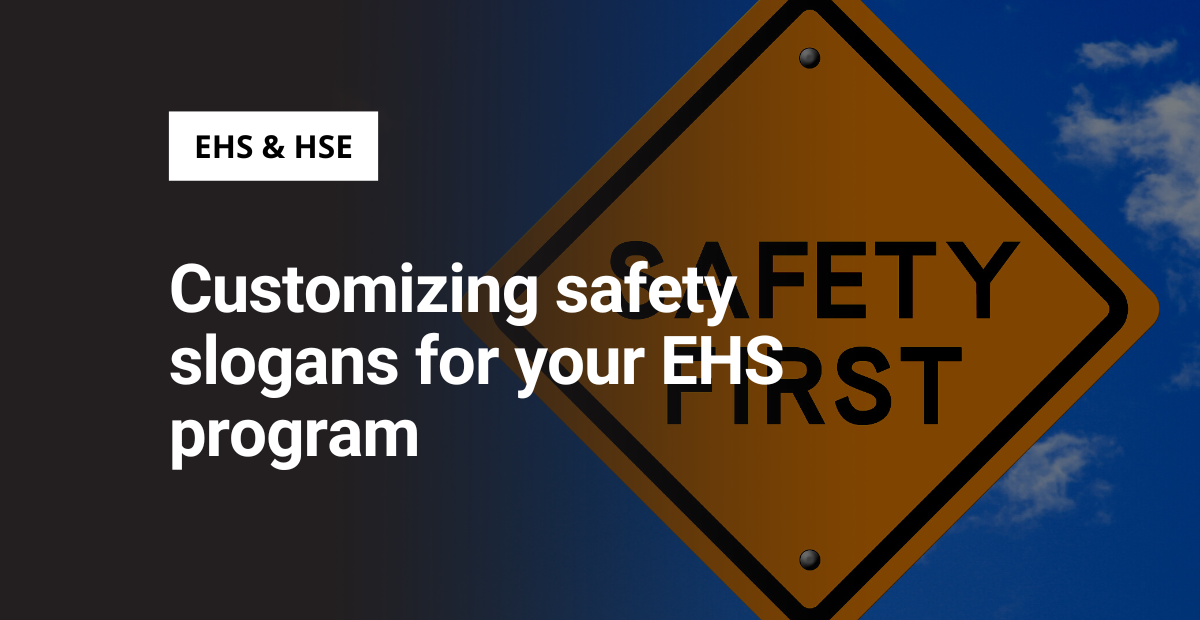You need buy-in from workers to create a safe environment. Incorporating effective safety slogans is key to getting that buy-in, as it requires you to motivate and inspire your team.
Slogans are typically considered marketing phrases, but they’re also useful for promoting safety programs. Indeed, having a cohesive, memorable safety slogan helps keep personal safety a priority amongst your workers.
There are many safety slogans already out there, but you may be looking for something fresh and/or original for your program. So, in this post, I’ll talk about some of the most popular slogans and teach you how to write your own.
Common safety slogans companies use
There’s nothing wrong with using a common slogan to promote your EHS program. Just make sure to personalize it in some way. After all, you don’t want workers to tune it out right away.
Check out some of these examples and my recommendations for how to make safety slogans your own.
Safety first
The “safety first” slogan is probably the most commonly used one out there. It’s straightforward but lacks depth. Nevertheless, the strongest pushback against this phrase is that it doesn’t clearly indicate why safety is first or who should be responsible for it.
I highly recommend watching his five-minute video by Mike Rowe which emphasizes some of the issues with a “safety first” approach without more meaning behind it:
If you want to customize this slogan, focus on the full scope by telling workers the areas of your business that fall under safety. Being more specific about your priorities provides more context and helps workers value personal safety over other areas like quality and productivity performance.
Safety is no accident
This slogan is more specific and emphasizes the accountability factor in safety. It does this without putting the blame on employees. Instead, it focuses on the fact that safety incidents aren’t inevitable, and employees should focus on what they can do to prevent them.
You can supplement this sentiment with top preventable “accidents” in your line of work. Give workers an alternative approach that they can take to avoid those incidents.
For instance: “Falls are no accident—look up and hook up.” Basically, this is an idea for a slogan you might use for workers who use fall protection gear.
Safety—it’s in your hands
One of the best ways to promote safety is to take the accountability angle. The fact of the matter is that you can only do so much to prevent incidents if your workers don’t take responsibility for their own safety.
One unique take on this safety slogan is to make it more specific to each area of the business. So, if you manage a warehouse and pickers who operate PIT equipment, you might say “fall safety—it’s on your back.” In this way, the phrase is more relevant to a habit you want your workers to form (hooking up to their harnesses).
Safety—do it for…
Another popular approach is to appeal to the emotional side of safety. It’s very common to highlight the answer to this question: “who are you returning home to after your shift is over?”
Examples of this safety slogan include:
- Safety—do it for your kids.
- Safety—do it for your loved ones.
- Safety—make it home safe to the people you love.
These are effective options, and they’re even better if you can mix it up.
Tips for writing effective safety slogans
Safety slogans exist to remind workers of the importance of safety protocols. An effective slogan is one that sticks, which means it needs to be easy to remember. Here are some tips for writing safety slogans that workers can hold onto:
- Keep your phrases short.
- Use repetition to make it memorable.
- Include action verbs to get workers to act.
- Create slogans for different areas of the process.
These strategies can help you craft an impactful slogan for all areas of your business—not just safety. Whether you’re looking to improve data management, productivity, quality, or any other area of performance, an effective slogan can encourage great habits.
With any of the common safety slogans in this list, using more than one is a great option. This keeps your program fresh and can prevent workers from becoming indifferent to the messaging.




